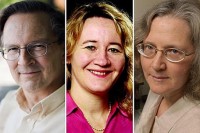Telomerase Provides Potential Cancer Treatment
 Three American scientists were awarded this year’s Nobel Prize in Medicine, for discovering how chromosomes are protected against degradation and for preparing the ground for a potential cancer treatment.
Three American scientists were awarded this year’s Nobel Prize in Medicine, for discovering how chromosomes are protected against degradation and for preparing the ground for a potential cancer treatment.
Elizabeth H. Blackburn, Carol W. Greider and Jack W. Szostak found that telomerase, a DNA sequence located at the ends of DNA strands, forms protective caps called telomeres, which seal the ends of chromosomes, preventing them from sticking together. In addition, they act as a molecular clock for the cells, regulating the ageing process.
In every cell division, the ends of chromosomes get shorter and shorter. If telomeres weren’t there, important genetic material would be lost in every division, causing genetic problems. Instead, telomeres get shorter. When they reach a specific length, the cell stops dividing, enters an ageing state and eventually dies. If telomerase activity could be increased to replace the missing parts, telomeres would not get shorter and cells would be immortal.
At first glance, this might seem like a fountain of youth and the key to eternal life. However, it would create even more serious problems than ageing: cancer.
Some types of cells, like ovaries and lymphocytes, have high levels of telomerase activity by nature, which maintains their telomeres’ length. “But what naturally happens to some cell types cannot be applied to a whole organism,” said Dr. Gerasimos Voutsinas, a professor of Molecular Biology at Deree College and researcher at Democritus Institute. “Consecutive proliferation of immortal cells usually leads to cancer.”
Cancer cells grow uncontrollably and become immortal due to their high telomerase activity. “Thus, by inhibiting telomerase activity there is a chance of treating some types of cancer,” said Voutsinas.
So, apart from providing the theoretical understanding of cellular activities, Blackburn, Greider and Szostak may have also paved the way to the development of new cancer treatments.
The three scientists will receive the award for their discoveries in the Nobel Prize Award ceremony in Stockholm on December 10.